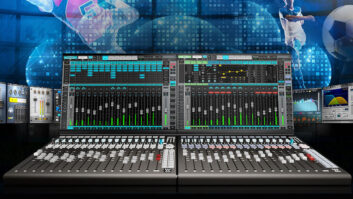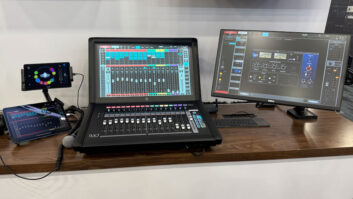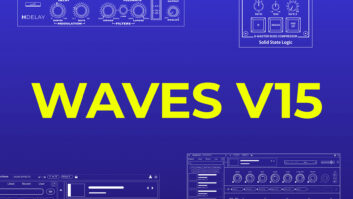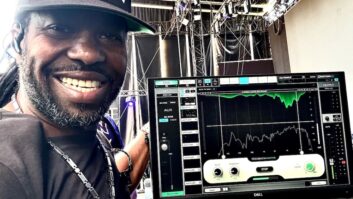For close to a decade, the award-winning Waves family of plug-ins have garnered accolades from users who love the clear sound, precise control and intuitive feel of the processors. Introduced at the end of 2000, Waves Gold Bundle 3.0 represented a new look and feel for the plug-in family. Essentially, Waves added design consistency between interfaces, introduced 88.2/96kHz support for some native platforms, got rid of the dongle and stuffed 20 plug-ins into one package. In this article, I’ll primarily cover the innovations found in Version 3.0. The latest Version 3.2 is a free update to Version 3.x customers. It isn’t a major change but provides bug fixes to increase system stability for TDM users.
Waves Gold Bundle comes in two flavors: Native ($1,300) and TDM ($2,600). Before you lose your cool over the price tag, keep in mind that you’d spend close to a grand for just the Renaissance plug-in family and the C4 Multiband Parametric Processor. The purpose of bundling is to offer a better deal on a full complement of audio tools designed to handle daily chores and unusual requests.
All plug-ins were tested on a Digidesign Pro Tools|24 MIXPlus TDM system running on a Mac G4 450 MHz (single processor). For software, I alternated between Pro Tools 5.1.1, Emagic Logic Audio 4.7 and Bias Peak 2.6.2, depending on the application. Some of the more DSP-intensive plug-ins — such as C4 and Renaissance Reverb — really need the MIX DSP resources to be of any use. However, Waves has found intelligent approaches to managing and sharing DSP allocation between most of its plug-ins via its Waveshell — a sort of DSP traffic cop. So, even host-based users should be able to handle various groups of plug-ins without having a session stop due to lack of DSP. The key is to plan around the DSP power at your disposal. Waves helps by breaking down some processors like Q10 into components made up of fewer bands.
On the surface, I love the consistent look and feel between plug-ins that Waves brought to Version 3.0. You can quickly sort out basic operations, as in buttons and metering, and adopt the darker console scheme found in the Renaissance collection, making it easier on the eye. Navigating is as easy as it ever was. You can quickly copy and save your settings, load them and A/B with other settings.
Each plug-in comes with several presets as good launching points and includes a convenient full reset. Multiple parameters can be controlled at once and automated within Pro Tools, so some of these algorithms can become performance instruments in capable hands.
BEHOLD: THE PLUG-INS!
If you want to check out the Gold Bundle, first go to www.waves.com and download a demo. Dial-up modems will take awhile, but you’ll end up with a two-week demo version that you can explore to your ear’s delight. If you want to buy at the end of the trial period, you won’t need extra hardware. Waves has moved to a dongle-less challenge/response approach that numerous software companies are favoring these days. Soon after, you’ll receive a hefty collection of manuals that are gloriously detailed with practical minutiae and historical references. I hate manuals, but these rewarded my patience.
L1 ULTRAMAXIMIZER
Some engineers get misty-eyed about this wonder limiter. Whether as a reliable channel insert to bring out a vocal or an instrument track or as a mastering tool, L1 has become an audio institution over the years. It’s even spawned a hardware version, L2, but that’s another review — in fact, it ran in the May 2000 issue of Mix, and can be found at www.mixonline.com. L1 junkies abound in studios worldwide, and have used and abused it on countless recordings. Engineers love the extra headroom and the density L1 adds to the mix. It’s a transparent, reliable studio limiter.
In the Version 3.0 bundle, Waves provides the standard L1 as well as the +L1 Ultramaximizer, a super L1 tailored for mastering that integrates IDR, Waves’ proprietary dithering and noise-shaping processor, and adds input level controls. With +L1, you get two types of dithering, as well as three levels of noise shaping. (You can dither down to 20-bit, 16-bit, 12-bit or 8-bit.) Also, both the L1 and +L1 Ultramaximizer are now 48-bit internal resolution dithered down to 24-bit, a feature shared with C4, S1 and the Renaissance Series, which we’ll cover below.
C1 COMPRESSOR/GATE
This Compressor/Gate (or Parametric Compander) plug-in is actually a three-in-one processor, with compressor/expander, gate/expander and sidechain filter modules. You can link a couple, all three or just select the component you need from a pull-down menu and save processing power for other chores. C1 includes three selectable modes: Wideband, Sidechain and Split. In Wideband mode, C1 provides common compressor functions; in Sidechain mode, a sidechain audio signal is filtered for band-specific compression; and in Split mode, the sidechain is filtered, but the signal is split into two bands — one active, one passive. The sidechain also includes a useful look-ahead limiting feature for precise response.
This is a workhorse plug-in that imbues no warmth or color to the sound (as opposed to the Renaissance Compressor). However, its ability to selectively compress, expand or gate any frequency band makes it a valuable asset. Plus, the manual, combined with an extensive setup library, is a great compressor tutorial. Also in V. 3.0, both the C1comp and C1gate can operate at 88.2/96 kHz in some native platforms.
Q10 PARAGRAPHIC EQ
The Q10 Paragraphic Equalizer is another bread-and-butter plug-in that’s improved with V. 3.0. Ten bands are available, although you can select down to a single-band Q1. Filter types are selectable between bandpass, low shelf, high shelf, highpass and lowpass. The filter design opts for constant bandwidth rather than constant Q approach — Waves’ rationale being that it makes control of the equalizer more intuitive. In any case, mousing around color-aided feels much smoother now. Q10 is great for everything from forensic jobs to automatic filter sweeps to pseudostereo treatments — though this application is best achieved with PS22 (described below).
S1 STEREO IMAGER
Wanna mess with the stereo field? Here’s your chance. S1 is a fairly easy plug-in to jump into. Increase or decrease the perceived width, rotate the stereo field back and forth, and generally freak out your listener. One of those plug-ins to throw in when you’re trying to find room for that special sample. I’ve used it on everything from spacey pads to filtered/delayed cymbals. In general, this is an excellent tool for subtle stereo-field correction on master recordings.
PS22 STEREOMAKER
The PS22 Stereomaker creates a pseudostereo effect, generating a stereo image from mono signal. It lacks any of the cheesy qualities that other purported stereo-izers have (read: very little phasi-ness). PS22 comprises three components: PS-Spread, PS-Split and DLA, the last being a companion that is used to compensate for delay and increase the stereo effect. You can get a smooth spread of the stereo image, achieve a hard left/right feel, and dramatize the stereo with DLA. I’ve favored it for ambiences, such as whispered vocals and solo woodwinds, but there are several setups to experiment with.
TRUEVERB
TrueVerb provides room emulation algorithms as launching points to tailor roll your own settings. TrueVerb creates a virtual space by treating source signal with two algorithms: one for multiple reflections generated in the first 100 ms, the second dedicated to actual reverb. All spaces are constructed from these building blocks. In my experience, TrueVerb is best when used with fairly dry recordings, such as a grand piano recorded in a living room. On acoustic recordings with clear reverberant traits, the plug-in needs to be used with more caution. This plug-in rewards anyone who understands the source material and the room. Don’t casually slap it on and expect to be pleased. Working from presets is especially recommended for the user to learn how acoustic environments are built. And, unlike the Renaissance Reverb, your DSP won’t get chewed up as bad.
DE-ESSER
A basic, reliable plug-in with adjustable parameters for sidechain frequency and threshold, DeEsser performs well on “esss” and “shhh” vocal troublespots. Some engineers are used to automating the “esss” out, but this plug-in is worth a try — and it is better than Digidesign’s stock de-esser. At press time, Waves had also introduced a Renaissance DeEsser for TDM systems as part of the Renaissance Collection 2 bundle ($400).
AUDIOTRACK
An all-in-one plug-in providing stripped-down, 4-band, parametric EQ, compression and noise gating, AudioTrack is a no-frills problem solver. AudioTrack is DSP-friendly and pretty transparent, but you’ll probably turn to it only when processor power is taxed. It’s useful on vocal and instrumental tracks that require minor tweaks.
C4 MULTIBAND PROCESSOR
C4 is a dynamics processor combining compression, expansion and limiting, de-essing and EQ, in one console. Best suited for working on the overall mix, C4 features a phase-compensated crossover and four separate compressors for discrete control of selectable frequency bands. Three crossover points and four frequency points are all draggable, providing a very flexible environment. C4 is frequently used in radio and TV broadcasts for maximizing loudness via multiband compression.
MAXXBASS
First choice for subheads, MaxxBass will create the appropriate rump-shaking treatment you need for dubby bass lines or the relentless, thumping drone on a house track. You can also easily replicate the distinct whoomp of dbx’s classic subharmonic synthesizer, as well as other idiosyncratic bass sounds. A patented technology, MaxxBass doesn’t boost the low end. Rather, it uses psychoacoustic principles to increase apparent bass frequency range. It works like a charm, and the presets and tutorial are excellent. It also includes dynamics and highpass filter controls to round out the sound. It’s also useful for low-res Internet applications, and it’s better than Aphex’s Big Bottom.
RENAISSANCE REVERB
King reverb. Hands down, one of the best reverb plug-ins available today. Warmer and more dramatic than TrueVerb, with a better interface, Renaissance Reverb (RVerb) gives you excellent halls, plates, rooms and chambers, plus odd presets such as ResoVerb and EchoVerb. It improves on TrueVerb’s early reflections algorithm and adds onboard EQ and reverb damping controls, with a Decorrelation parameter to fine-tune the color of the sound. As with L1, all processing is 48-bit internal dithered to 24-bit. (Note: This plug-in eats up DSP with abandon and might exhaust your resources faster than you think.)
RENAISSANCE COMPRESSOR
The Renaissance Compressor (RCOMP) has all of the common compressor controls, plus the added benefits of “warmth” controls, as well as Electro and Opto mode switches. Leaving C1 in the dust, this is the closest a plug-in comes to a vintage LA-2A or a current Summit DCL-200 — just don’t expect it to replace either one! It’s an excellent choice for drum overheads or across the entire mix. Between this and the Focusrite d3, I cover pretty much all I need to do. RCOMP includes Waves’ ARC® (Automatic Release Control) technologies, and all processing is 56-bit internal dithered to 24-bit. The only thing I found wanting was the lack of a sidechain, but you can’t have it all. This plug-in is so good, it’s silly.
RENAISSANCE EQ
As with its companion plug-ins, the Renaissance EQ (REQ) adds a warmer resonance to a source signal. Partly modeled on the action of the Pultec EQs, the REQ is a 6-band EQ with frequency, bandwidth, gain control and an EQ window with draggable elements as found in Q10. Bands 1 and 6 are selectable between cut and bell, low- and highpass filters, and resonant shelves; and bands 2 through 5 are bell filters and resonant shelves. The REQ’s emulation of analog filter action is very impressive. All internal processing is 48-bit, and you can select between 2, 4 and 6-band versions.
MONDOMOD
This modulation plug-in combines rotation, amplitude modulation and frequency modulation algorithms in one environment. Respectively, they provide autopanning, tremolo and vibrato treatments that can be combined to create very unusual effects. MondoMod depends on selectable LFO waveforms to modulate volume, frequency and rotation. A tempo feature adjusts the frequency of the LFO, and you can set the bpm to match the tempo of a song. Worth digging deep into for swirling effects and 3-D ambiences.
METAFLANGER
MetaFlanger provides great flanging, phaser and chorus treatments. Various cool settings are provided, including homage to classic Mutron Biphase and MXR units, as well as Ampex 440 tape-flanging emulation, which is excellent. Filter types toggle between lowpass and highpass with a selectable corner frequency. Base delay times are selectable between 0.1 and 50 ms, and a Tape button provides added flanging emphasis. You can set the LFO rate between 0 and 20 Hz, though waveforms are only selectable between triangle and sine. A useful Stop button will freeze the modulator for more precise processing work. You can also set the stereo spread between mono (0°) and full stereo (180°). Excellent for guitar and drums fills.
ENIGMA
Like the MetaFlanger, Enigma includes phasing and flanging effects. But it’s a much more complex animal with interdependent reverb, feedback and filtering environments. It’s the least predictable of all the plug-ins, hence the name. The plug-in has two main sections: an upper “notch” control window with up to 12 frequency sweeps, and a lower Feedback section that acts as an echo/reflection generator. A depth slider controls the depth of the notches, and there’s a Phase button to reverse the polarity of the notches. There are five LFO shapes to choose from, as well as a rate/bmp parameter that was highly useful for mutating drum loops. Best for deconstructive remixing chores, Enigma merits hours of study.
DOPPLER
Although there may be limited applications for Doppler effects, this plug-in does much more. Doppler’s main window contains a curved line with a start point, end point, a center handle to adjust the curve and a red dot at the window’s bottom denoting the listener’s position. You can adjust the time for the Doppler effect to fly by, and tweak reverb, panning, pitch shift and air-damping parameters. Though Doppler excels at realism, I used it to morph a conga loop into an alien tabla/udu drum performance. Dopper is a hidden gem in the list.
ULTRAPITCH
Pretty cool, but at times a challenge to control, UltraPitch is a formant-correcting, 6-voice pitch shifter and harmonizer. Ultra-Pitch will detect a pitch and shift the note, leaving the harmonics intact. Or, you can mess with the harmonics while leaving the pitch untouched. Creating complex three-part vocal harmonies is possible, but it’s no substitute for hired talent. That said, UltraPitch provides great gender-bending effects, and it does a decent job of emulating stacked vocals. I used it for morphing guitar and brass passages, though a slight delay (due to a look-ahead feature) limits real-time applications. Cool features include an Animation control to approximate what several singers would sound like, as a well as a keyboard graphic interface for setting intervals.
SUPERTAP
This plug-in provides immediate gratification, with no real learning curve — just insert and play. There’s a 2-tap and a 6-tap version (available only with Gold Version), each tap with its own gain, panning (or rotation), EQ and up to six seconds of delay time. A panning graph provides color-coded representation of each tap, which you can grab and move in the window. There’s a great Tap button to set tempo, and SuperTap performs tempo averaging for accuracy. A Mode button can be set to Tempo or Pattern; in the latter, SuperTap will learn and reproduce the rhythm you tap in — great for building complex looping parts. There are good feedback features, and feedback loops can be routed through SuperTap’s Rotation feature to move delays in the stereo field — a looper’s delight.
PAZ PSYCHOACOUSTIC ANALYZER
Waves has provided an excellent diagnostic tool in PAZ, a psychoacoustic analyzer comprising three sections you can call up independently. A Frequency window (RTA) shows real-time frequency display across 52 bands based on how the ear typically responds. There is a Stereo Position Display (SPD) that shows distribution loudness across the stereo field to help sort out phasing issues, and there are peak and level meters. One good feature is that RTA can be set to Peak mode or RMS mode, where the energy read-out is averaged over time.
PACKING UP YOUR TOOLS
Waves 3.2 is a versatile toolbox that verges on providing an embarrassing amount of riches. Hands down, the strongest plug-ins are the Renaissance Collection, plus C4, L1, SuperTap, MaxxBass and Doppler. And for pure weirdness, Enigma is your ticket. Most of these plug-ins will be useful for years to come, so the bundle is a lasting investment. The only thing that was missing was a spring reverb plug-in, where slapping the side of your CPU creates that familiar, hollow “sproing” effect. Maybe in V. 4.0.
Waves Inc., 306 West Depot Ave., Suite 100, Knoxville, TN 37917; 865/546-6115, fax 865/546-8445; www.waves.com.
Alex Artaud is a musician and engineer living in Oakland, Calif.






